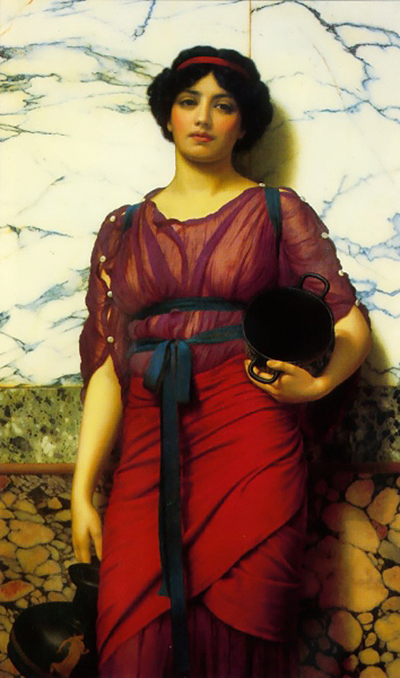The works of John William Godward (1861-1921) belong to the school of art known as Neoclassicism. This genre of art emerged in the late eighteenth and early nineteenth centuries, and it is typified by images of beautifully-rendered, statuesque females in pastoral settings.
Common motifs are classical ruins and abundant foliage surrounding the subject of the painting, who is usually posed in a position suggesting that she is part of a wider narrative. In contrast to the saints and angels of the earlier and later Renaissance, many Neoclassical female subjects were painted to please the male gaze. Godward painted in oils, a medium that enables the artist to render subjects vividly and realistically.
He exhibited his works at the Royal Academy, and was an admirer and imitator of Sir Lawrence Alma-Tadema (1836-1912). The commissioner of Grecian Idyll, painted in 1907 is unknown and most likely, Godward painted it as an artistic speculation. In common with Alma-Tadema, Godward paid painstaking attention to architectural details, and the rendering of animal skins, human flesh and fabrics. Even when these artists painted mythical subjects, for example, a cupid, the rendering of the wings had to be realistic and copied from nature. The viewer can see this meticulous rendering in Grecian Idyll. The female subject is posed against a backdrop of three types of stone.
The top layer is pale marble veined with grey, and its austerity throws the rich, dark hair and apricot-coloured flesh of the female into relief. The peach tint in her cheeks, the red of her pouting lips and the thrust of the heavy breasts are all suggestive of ripe pieces of fruit. The exotic red and purple of her clothing are further suggestive of fertility and fecundity, while the water jars that she carries in either hand indicate that she is a nymph. Aided by the fall of the blue sash, the eye travels downwards and darker, granite-type marble replaces the paler top layer. This darker territory coincides with the woman’s loins and beneath this granite layer is a mass of glowing red haematite, further suggestive of sexual danger. In the repressed, Victorian society in which he painted, Godward would have found a ready clientele for such works. Today, Grecian Idyll is in a private collection.




